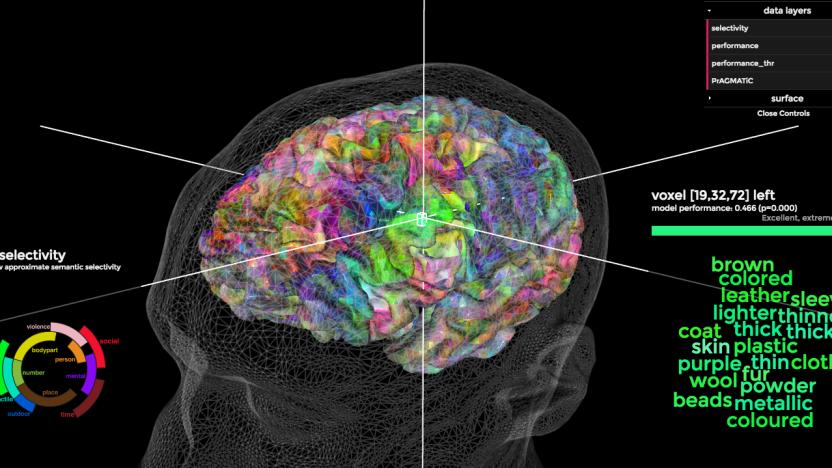BrainMapping
Latest

Presenting the most comprehensive map of the human brain
Ask a neurologist -- as far as brains go, humanity has one of the largest and most complex thinking muscles on the planet. That's why researchers have never really had a good atlas of the human brain's underlying structure. According to the Allen Institute, documentation on the model of the human brain is so outdated, that it's still commonplace for scientists to reference mappings from almost a century ago. Well, at least it was: the Institute has just published what it says is the highest resolution atlas of the human brain, one it hopes will become a new standard resource for brain researchers.

Scientists use 'Moth Radio Hour' to map meaning across the brain
Researchers at the University of California, Berkeley took on the complex task of mapping meaning along the cerebral cortex, the thin membrane that stretches across the entire brain, and their results suggest language is much more complex than previously thought. Seven volunteers listened to The Moth Radio Hour, a program where people share emotional personal tales, while lying in a functional MRI machine that tracked how their brains responded to 985 specific concepts, Science News says. Researchers mapped the blood flow to 60,000 to 80,000 pea-sized regions across the cerebral cortex, resulting in a dense word map covering the entire brain. Turns out, some concepts showed up in several areas across the brain: "Top," for example, appeared in a section that handles clothing and one that deals with numbers.

Neuroscientists accurately predict intelligence with an fMRI scan
If fingerprints can identify individual people, imagine what a brain-print could reveal -- namely, how you think and how intelligent you are. Neuroscientists studied fMRI scans of 126 patients in the Human Connectome Project, a consortium helping to map the human brain, and found consistent connections that accurately predicted "fluid intelligence," or abstract reasoning. Their findings were published today in the journal Nature. Researchers found that the more certain regions of the brain spoke to each other, the more likely a person was to quickly process information and make inferences, Yale grad student and study co-author Emily Finn told Wired. For example, a strong connection between the frontal and parietal lobes, two areas involved in high-level functions, accurately predicted a high fluid-intelligence score.

GE's Neuro VR experience takes you inside a musician's brain
"Welcome to the complex universe inside Reuben's head." A mysterious voice boomed through the headphones. With an Oculus headset strapped on my face for GE's Neuro VR experience, I found myself moving through British musician Reuben Wu's mind. Bright pink globes and interlinked pipelines flashed before me. What was meant to be anatomical, felt more industrial. It was underwhelming. But soon, the globes made way for a dark abyss and I watched as the neurons inside his brain came to life. They gently sparked and burst into little bolts of neon lightning, replicating the magical, interconnected workings of the complex organ.

Allen Institute completes gene expression map of the human brain in high-resolution 3D
As a species, we've spent a lot of time learning how the human brain works, but we've had to go without a true, thorough map of how genes manifest themselves in our craniums; previous maps have been limited to the simpler minds of mice. The Allen Institute for Brain Science is now known to have solved that mystery by recently finishing an extensive, detailed 3D atlas of genetic expression within our own brain tissue. Accomplishing the feat required no small amount of resources, including the definition of 900 subdivisions, conducting over 62,000 gene expression probes and producing the MRI scans of two and a half brains, but the result is a potentially vital tool for neuroscience and education. Curious web users can see a visual map of gene expression based on virtually any criteria they need, whether it's a physical region of the brain, a disease type or the exact gene they'd like to track down. For many, the best news about the map may simply be that it's free and public: anyone with enough experience in genetics can learn more about what makes the mind tick through their browsers, and what they find might just lead to new discoveries.



